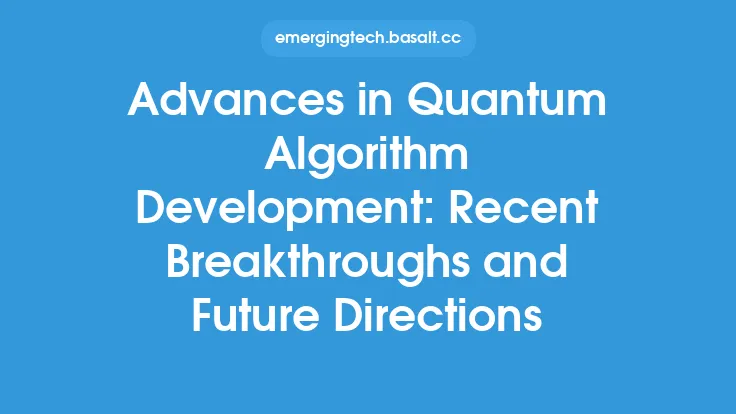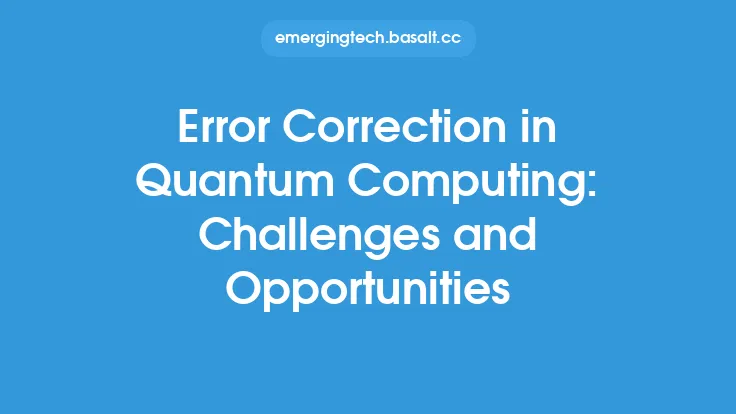The field of quantum error correction has witnessed significant advancements in recent years, driven by the need to develop robust and reliable quantum computing systems. Quantum error correction is a crucial component of quantum computing, as it enables the detection and correction of errors that occur during quantum computations due to the noisy nature of quantum systems. In this article, we will delve into the recent developments and breakthroughs in quantum error correction, highlighting the key concepts, techniques, and challenges in this field.
Introduction to Quantum Error Correction
Quantum error correction is a set of techniques used to protect quantum information from errors caused by decoherence, noise, and other quantum-mechanical phenomena. Quantum systems are inherently fragile and prone to errors, which can quickly accumulate and destroy the fragile quantum states required for quantum computing. Quantum error correction codes are designed to detect and correct these errors, ensuring that the quantum information is preserved and the computation is executed accurately. The development of robust quantum error correction codes is essential for large-scale quantum computing, as it enables the creation of reliable and fault-tolerant quantum systems.
Recent Developments in Quantum Error Correction Codes
Several recent developments have improved the efficiency and effectiveness of quantum error correction codes. One notable example is the surface code, a topological quantum error correction code that has gained significant attention in recent years. The surface code is a planar code that uses a 2D array of qubits to encode quantum information, providing a high degree of error correction and fault tolerance. Other notable developments include the development of concatenated codes, which combine multiple layers of error correction to achieve high levels of error correction, and the creation of new codes such as the Gottesman-Kitaev-Preskill (GKP) code, which provides a high degree of error correction for continuous-variable quantum systems.
Advances in Quantum Error Correction Techniques
In addition to the development of new codes, several advances have been made in quantum error correction techniques. One notable example is the development of machine learning-based methods for quantum error correction, which use machine learning algorithms to optimize error correction protocols and improve their performance. Another example is the use of dynamical decoupling techniques, which use carefully designed control pulses to suppress errors and improve the coherence of quantum systems. These techniques have been shown to be highly effective in reducing errors and improving the performance of quantum systems.
Experimental Demonstrations of Quantum Error Correction
Several experimental demonstrations of quantum error correction have been reported in recent years, showcasing the feasibility and effectiveness of these techniques. For example, a team of researchers demonstrated the use of quantum error correction to protect a quantum system from decoherence, achieving a significant improvement in the coherence time of the system. Another team demonstrated the use of surface codes to correct errors in a quantum system, achieving a high degree of error correction and fault tolerance. These experimental demonstrations highlight the potential of quantum error correction to enable reliable and fault-tolerant quantum computing.
Challenges and Future Directions
Despite the significant advances in quantum error correction, several challenges remain to be addressed. One major challenge is the development of scalable and fault-tolerant quantum error correction codes, which can be implemented in large-scale quantum systems. Another challenge is the development of more efficient and effective error correction techniques, which can be used to correct errors in a wide range of quantum systems. Future research directions include the development of new codes and techniques, such as topological codes and machine learning-based methods, and the experimental demonstration of these techniques in a variety of quantum systems.
Conclusion
In conclusion, the field of quantum error correction has witnessed significant advancements in recent years, driven by the need to develop robust and reliable quantum computing systems. The development of new codes and techniques, such as surface codes and machine learning-based methods, has improved the efficiency and effectiveness of quantum error correction. Experimental demonstrations have showcased the feasibility and effectiveness of these techniques, highlighting the potential of quantum error correction to enable reliable and fault-tolerant quantum computing. However, several challenges remain to be addressed, including the development of scalable and fault-tolerant codes and the creation of more efficient and effective error correction techniques. Future research directions include the development of new codes and techniques and the experimental demonstration of these techniques in a variety of quantum systems.





